In large cities, a taxi is a popular transportation means. Every day yellow cabs help thousands of people reach their destination in time. With modern technology, catching a ride is pretty straightforward. You don’t need to stand in the street looking for a car — you can just open a unique app for taxi booking and order a cab.
Contents:
No wonder developing such apps is a pretty lucrative field. By 2026, the total number of their users will reach 97.2 million. At the same time, a projected market volume will hit $74.45 billion.

Projected revenue growth for the taxi app market
Uber is one of the most popular taxi apps worldwide. The company owns 55% of the whole market. Uber quickly became the most downloadable taxi booking app, with a peak of 11.6 million installs in February 2020.

Uber owns 55% of the U.S. market.
A mobile application will be a massive advantage for your small taxi business or startup idea. It’s an excellent way to attract more potential clients and drivers and expand your influence to nearby cities.
So, let’s see how to make an app like Uber. We will dwell on business processes, mobile app development, and cost estimation. Plus, we’ll give you some valuable tips along the way.
Project planning as a starting point
Before giving the green light to actual development, you need to prepare for the long ride.
The first destination of your journey is project planning and market research. What’s in high demand now? What taxi applications are prevalent in your region or worldwide? Gather as much data as possible, then write a detailed business plan with the most beneficial pricing model.
Pricing model
Speaking of which, there are several pricing models for apps like Uber to make money:
- A basic fare that depends on the car type and region;
- Cost per minute, where the price is calculated according to the GPS data;
- Cost per mile, where everything is based on the driven distance;
- A booking fee that is charged when a person books a car.
Usually, mobile apps of this type use a mixed pricing model to get more income.
Monetization
The next thing you need to consider is monetization. That is, how you will earn money from your app. The taxi booking apps have three types of monetizing:
- Ride fares that you take from each client;
- Fines for canceling a ride at any moment;
- Commissions or taking a part of the income from each driver.
You can mix the monetization type and combine fines with commissions. The latter can be really high. For example, Uber charges a 25% fee on all fares.
Portrait of the user
Finding the target audience for your future application is vital. If you guess it right, you will gain more regular users. How to create an app like Uber and find your audience?
Conduct several kinds of research to discover what type of people use taxis more often than others. What are their age, occupation, and area of living? What do they like and dislike?
After you receive the results, create a segmented map of your audience. Grouping potential users allows you to discover a niche for your mobile app. What’s more, you’ll be able to identify first-time buyers and repeat customers. Later, you can build a marketing strategy around this community.
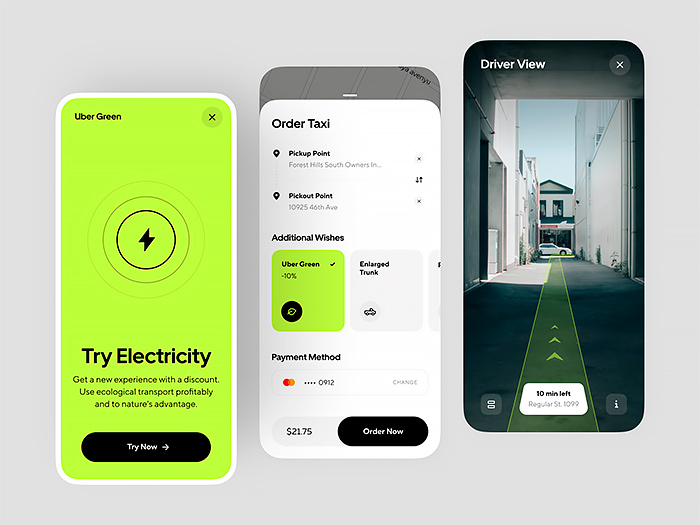
Uber Green app concept by Shakuro
Root of the problem
The portrait of the target audience is the key to identifying the user problem. It should be the main reason why they are using apps for Uber taxis or other similar applications. In this case, the absence of a car is not necessarily the only pain. It can be the distance, timing, health issues, weather changes, and whatnot.
We like to think of Uber as the cross between lifestyle and logistics, where lifestyle is what you want, and logistics is how you get it there.
— Travis Kalanick
That’s why it’s crucial to figure out what motivation urges your target audience to grab a mobile phone and order a cab. The closer your mobile app will be to the problem solution, the more success it will bring.
Analyze your competitors
It often happens that you don’t need to reinvent the wheel. You are not the first to make an app like Uber. If you open popular charts, you will see dozens of applications for ordering a taxi developed by both enterprises and mid-market companies. It’ll be wise to take a closer look at each of them and explore how your competitors implemented this or that feature.
Use various techniques like SWOT analysis to study the results. The deep insight allows you to identify your strengths and weaknesses. If you discover your competitors’ downsides, you will also understand what mistakes to avoid during mobile app development.
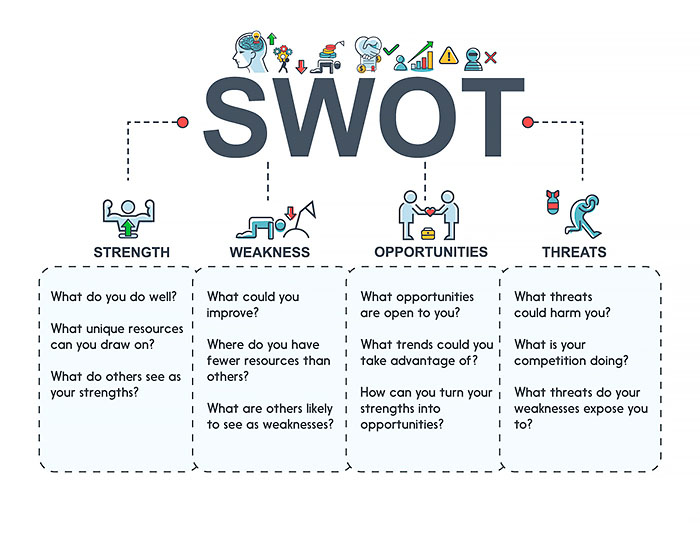
SWOT table by Feedough
Don’t copy and paste their solutions, though. That’s a bad practice. Instead, perform case studies, adopt the competitors’ way of thinking and wrap it into your unique app design. A one-of-a-kind approach will help your mobile application to be on par with leaders in the market.
Also, try not to fall for each feature you like. Opt for those solutions that will work stable with your technological stack and suit your target audience. You won’t impress people with poorly implemented features.
Start with MVP
If you have doubts about the mobile design, consider launching an MVP first. It’s a minimum viable product with few must-have features. The basic version of the app allows you to attract the first users, gather early feedback, and check if your assumptions were correct. If your mobile app fails to win people’s hearts, it’s not the world’s end. Fix issues encountered in MVP and launch a major update.
Moreover, developing an MVP will take less time and money than creating a full version. It shortens the development cycle, and the team can start working on the improvements much quicker. These features makes MVP a great idea for mobile development for startups.
How does the Uber app work?
The main principles of a taxi app are relatively simple. A client submits a request for a ride from point A to point B. The app calculates the cost based on the distance, cab comfort, and service charges. Then it matches a client with the closest driver available. If they accept the request, the user gets to the final destination and pays when the ride is over.
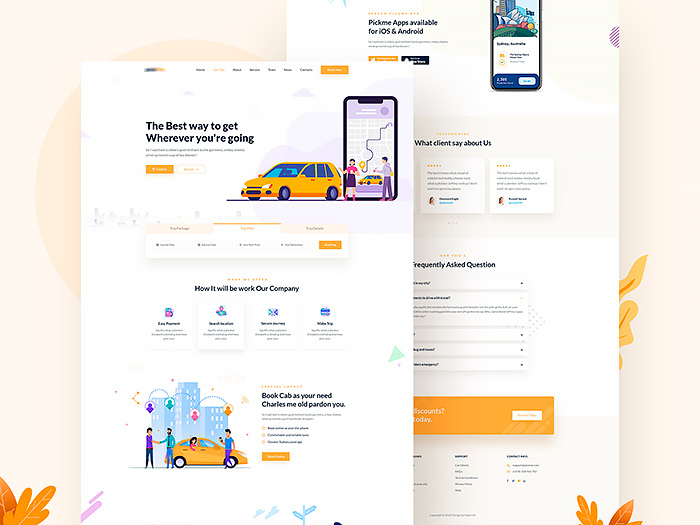
Online taxi booking website by Habib Hemel
These principles also apply to the Uber app. If we look deeper, we can divide the workflow into several steps:
- A client opens the app and selects a destination using an interactive map. They see a pre-calculated price based on several parameters we mentioned earlier;
- The client confirms the order with the chosen options;
- The app looks for the nearest drivers that meet the client’s requirements in the database. The driver can accept or decline the request. If the request is rejected, the app continues matching the order with suitable drivers;
- Once the ride starts, the client can use the interactive map to follow the progress. The driver uses the map to navigate through the city streets and avoid any traffic jams;
- When the ride is over, the system charges the client automatically according to the selected payment option. Both the driver and client can provide feedback on the ride to improve the user experience. The app adds the ride into the user’s history, and they can access it anytime.
Uber is a sustaining innovation; that is, it makes customers’ lives better. Uber targeted mainstream markets with a better service for existing customers, and it succeeded in serving them better than the incumbents.
— Clayton M. Christensen
Apart from the client’s app, there is also a driver app for Uber taxi. So, to provide a high-quality service, you will need to develop two separate versions of the same application. They will have different features and UI\UX design. In addition, you will probably have to create a dashboard for administrators who oversee the service if you still don’t have one.
Let’s take a closer look at both versions: for clients and drivers.
What features should apps like Uber have?
Features for clients
Here is a list of the must-have mobile app features for your future clients:
- Creating an account and signing in \ out. A person should be able to create an account and authorize it on the first launch using a phone number, e-mail, or social media (Google, Facebook, etc.). The profile allows the client to personalize and set up the app to their needs: adjust notifications, choose payment methods, add addresses they frequently visit, etc.
- Entering an address and booking a car. With the help of an interactive map, the client can select a place for a car ride and submit the order. If they don’t know their exact location, they should be able to order a cab with the help of a mobile GPS.
- Tracking a driver and following the trip progress. The same GPS technology allows the user to see the driver on the map. Intelligent algorithms estimate the time until the driver arrives, and the app shows it to the client. This feature is also useful when tracking the ride progress on the road, in case someone doesn’t know the exact route. You can’t leave them in the dark.
- Traveling history. This option helps the user to find and check the extensive info on his past rides. Then they can leave a review, check an address for a specific place, count expenses, etc.
- Sending messages and push notifications. It’s one of the critical features of an app like Uber. This option establishes communication between the user and the driver. If the client is getting late, they can message the driver. The push notifications warn about car arrival a few minutes beforehand, even if the mobile app is minimized.
- Paying for the order. Everything has a price, even a taxi ride. A person should have a variety of payment options. Besides credit and debit cards, it’s better to include services like PayPal, ApplePay, and GooglePay. A client may not have the card or NFC, so it’s better to let the system charge the card connected with the user profile in the app settings. Alternatively, you can add another vital option — paying with cash.
- Providing customer support. However great an app can be, its users will probably still encounter various problems while using third-party services like payment or the Internet connection. For the best experience, a client should be able to get help from the support team via a live chat or direct call.
- Leaving reviews. Let people express their opinion not only about your app but also about current and past trips, drivers, trip experience, etc. The reviews will encourage users to provide better and safer services.
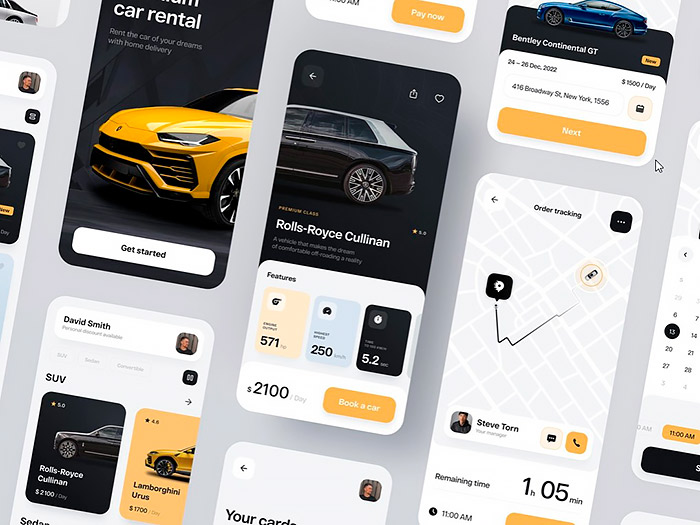
Car rental app by Conceptzilla
Features for drivers
Apart from features that the user application has (messaging, ratings, pushes), a driver app for Uber must include special features:
- Optimizing route with GPS. A driver should be able to avoid traffic jams or roadworks with interactive map navigation. For example, third-party services like Google Maps provide extensive info on traffic problems, shortcuts, etc.
- Notifying about new orders. Send popups when a new ride is available. Allow the driver to check all the essential info like the person’s name, address, and expected price, then let them decide whether to take the order or not.
- Verifying for new drivers. To keep your rides secure, each rookie should undergo verification. The administrator will check their driving license, car documents (if they use their own), insurance, past fines, etc.
- Creating daily, weekly, and monthly revenue reports. Dashboards showing income and expenses will bring clarity to the workflow.
These are all the necessary features when you create an app like Uber. Without them, the service will drastically drop in quality.
These lists don’t stop you from adding other options as a bonus to enroll more users. For example, you can include the split payment feature, pre-ordering for a particular time, and even gamification with achievements.
You need to possess a specific stack of technologies to implement the desired features.
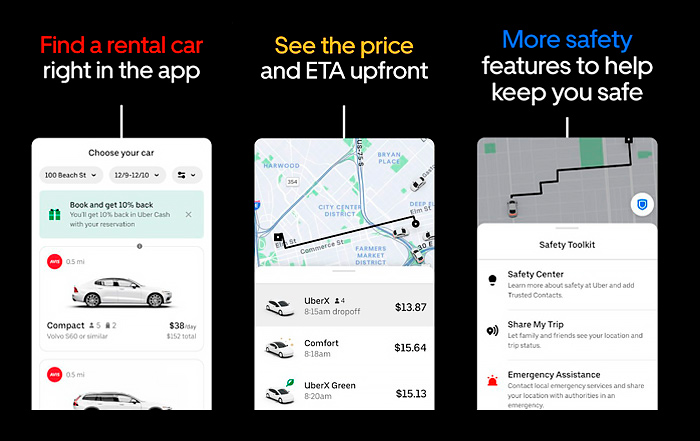
Uber app screenshots on Google Play
What technologies do you need to develop an Uber-like app
First and foremost, you need to decide on the release platform. If you go for Android and iOS, your team will have to split its forces using different platforms’ kits. Moreover, these mobile OS have huge differences in app design, development cost, distribution and store optimization.
That’s why, selecting one platform for a first-time project or startup is a wise decision.
Second, you need to pick technologies for each part of your project:
- Application. Here you can opt for any popular programming language, for instance, Objective-C, Java, or Swift.
- Back-end services. Usually, companies use Node.js, PHP, or Ruby on Rails.
- Databases. Consider using MongoDB and MySQL to keep various statistics and important info safe. They are robust and resistant to heavy loads.
- Geolocation. The service depends on the platform you choose. The Android app requires Google Maps, Google Location, and their API. For iOS, you must get Apple Map API or MapKit.
- Payment. Connect your mobile application with third-party services like PayPal, ApplePay, and GooglePay. For conducting payments, you can use Braintree. It performs all operations automatically, like refunds, monthly\weekly\annual fees, and allows you to build a split payment option.
- Push notifications. Here you can use native solutions from the platforms (Google Cloud Messaging or Apple Push Notification). Alternatively, you can take third-party APIs like Twilio, Nexto, etc.
Uber has an information advantage, a computational advantage. There are massive structural advantages to the player who’s smartest about how to deploy cars, where to deploy cars, how to adjust pricing dynamics, how to ensure supply of drivers – the party that understands best the behavior of riders.
— Chris Sacca
You can adopt many other solutions to enhance your mobile app. For instance, utilize marketing services for better KPI, growth hacking, app rating and statistics improvements. Alternatively, youc an create a strong customer support, and get detailed crash reports.
They are vital for excellent service but not obligatory for your app to be released on the market.
How much does it cost to make an app like Uber?
The app development cost depends on various factors: release platform, number of implemented features, market region, team location, and expertise. You must also calculate costs for UI\UX design, QA engineering, usability tests, etc.
You can potentially reduce development costs by up to 50% if you hire an outsource development team. In this case, the average hourly price is $40-45 for development and $70-80 for design.
Simple app
If we take a project from scratch, with a simple UI and few frames, the rough estimation is:
- Around 310 – 480+ hours
- Approximately $12 400 for the development
- About $21 700 for the design
Complex app
If you want to spice up your creation with premium features, then the rough estimation will be much higher:
- Around 690 – 1680+ hours
- Approximately $27 600 for the development
- About $48 300 for the design
Based on the team and features, the mobile app development cost can vary from approximately $34 100 to $75 900 and higher.
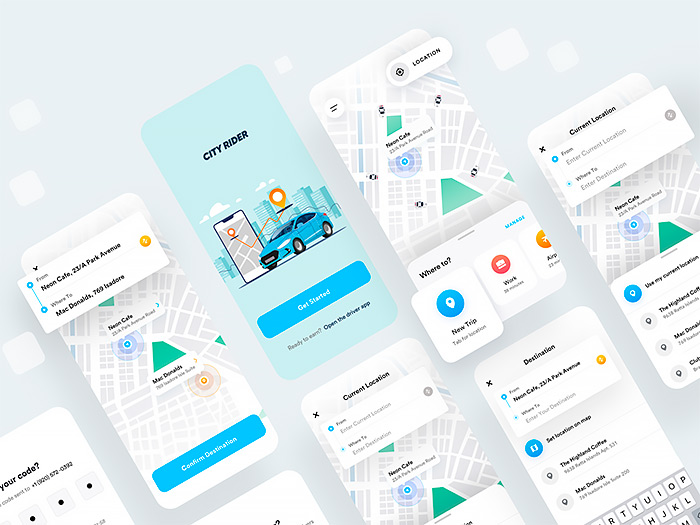
City Rider app design by Dibbendo Pranto
Additional costs
Apart from the development costs, you must include other vital things in the budget. There are high chances you will need:
- Promotions and advertising
- Domain, hosting, or a dedicated server
- Placement into mobile stores
- Reviews and future updates
Since the approximate costs can easily hit around $100 000, designing an app like Uber is extremely hard or even impossible for startups or small businesses. However, they can still get in game with mid-market companies and enterprises providing they find enough investors.
Overall, it’s better to build a project around the real budget and make all the decisions hard-headed. Plan everything beforehand, and try to predict all possible risks. Opt for the premium features if you have enough money and knowledge.
Conclusion
There are many competitors in the taxi market: Uber, Lyft, Gett, Curb, and hundreds more. It will be hard to win the place under the sun against them all. However, if you create a neat app with many useful features aimed at the right people, your company will have high chances to become a well-known taxi service.
Ready to develop an Uber-like app and make your way to the top? Contact our team, and we will ensure you get the best result possible.
